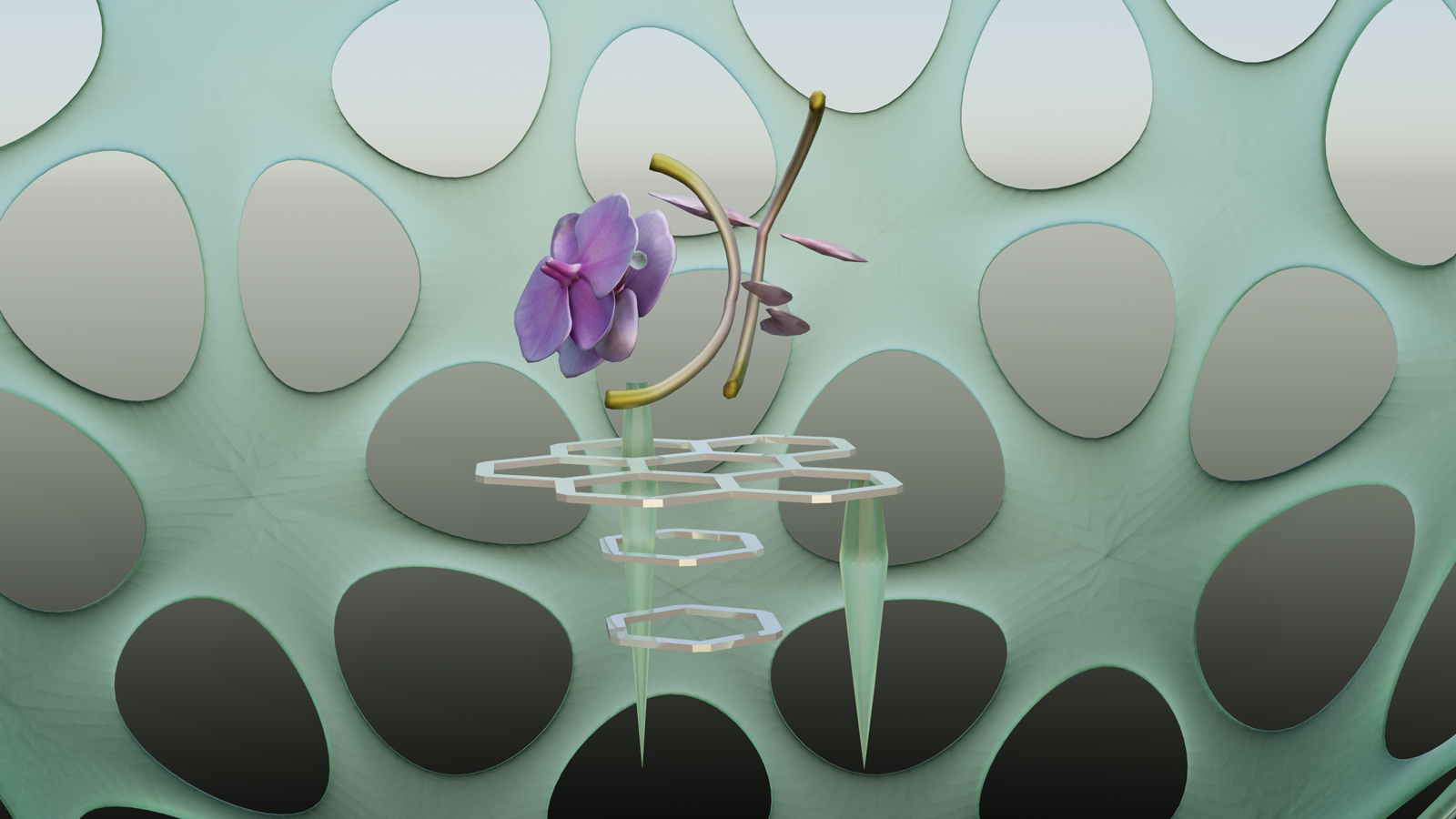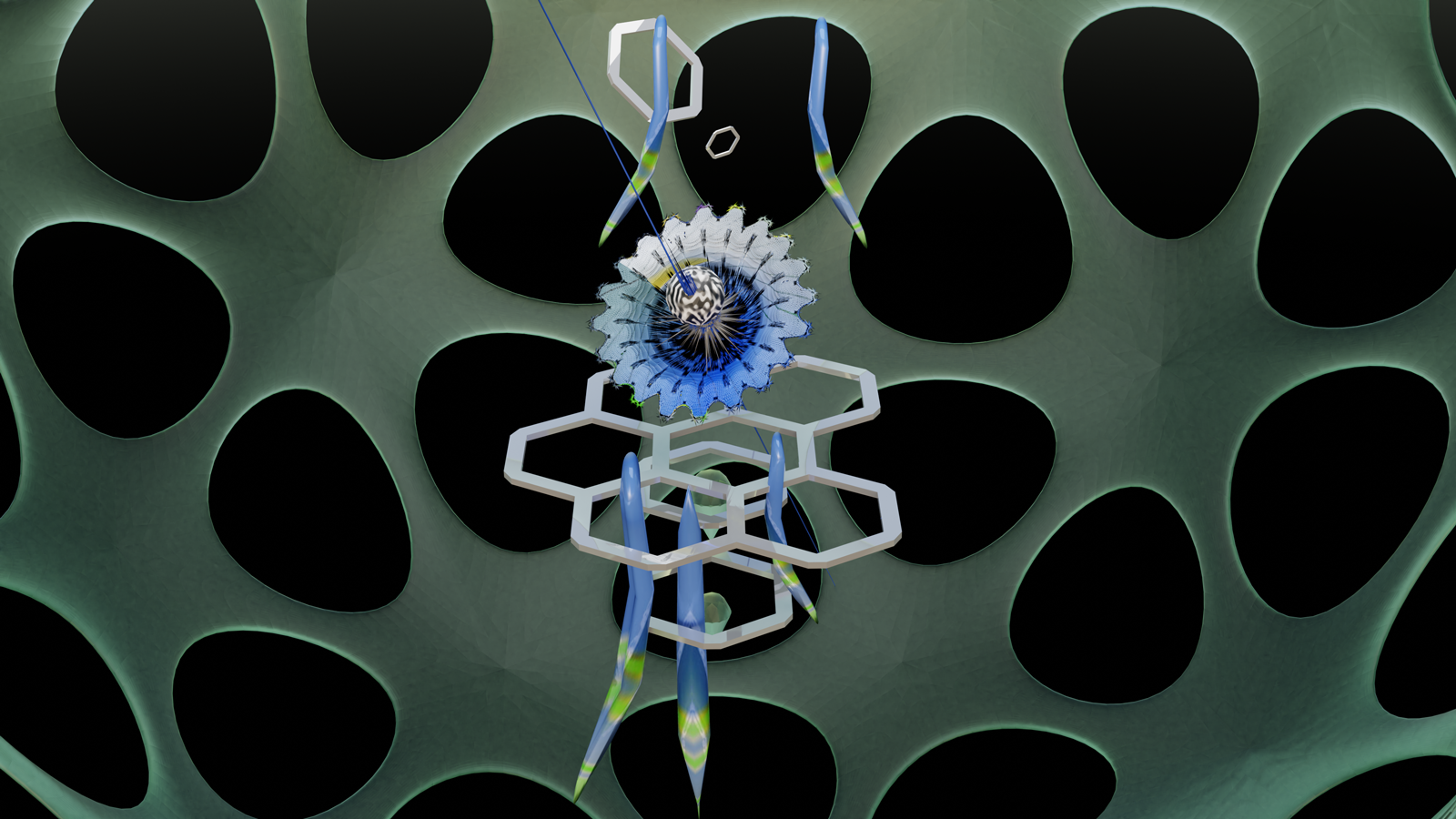FLOWr
AvantGarden: FLOWr by Tanja Vujinović
Audio-visual artworks
3D graphics: Tanja Vujinović
Production: Ultramono, 2021.
FLOWr 1 by Tanja Vujinović
Video work, 0:20 minutes
Production: Ultramono, 2021.
FLOWr 2 by Tanja Vujinović
Audio-visual work, 2:53 minutes
(horizontal and vertical versions)
Production: Ultramono, 2021.
Consulting
Slavoljub Tasić, Institut "Dr Josif Pančić", Beograd
Kristina Bukač, Informatics engineer
Prof. George Poinar, College of Science at Oregon State University
Dr Jelena Guga, researcher
Thimster, Graphics Design Master
Dr Vid Podpečan, Department of Knowledge Technologies, Jožef Stefan Institute
Ivan Stanić, curator and artist
Derek Snyder, researcher and editor
What did the first flower that appeared on planet Earth look like? This question can be answered through Platonic, universal forms, mythological forms that kept reappearing throughout art history, or algorithms that nature uses in constructing biological forms.
Mythology, religion and popular culture abound in the symbolism of plants, which independently or intertwined with other living existing or imaginary forms perform various functions in culture. They are at the same time protectors, guides, but they also intimidate with their not completely revealed alkaloid contents and the effects they leave on our senses. While alluring but also essential for human survival, the first flowers may have existed up to 100 million years ago, and many paleobotanists work on the puzzle of how the first flowers looked.
From orchids as representations of most seductive and diverse flowers on Earth, to poisonous plants from Datura family, imaginary artworks from the FLOWR series also draw inspiration from science of nano-structured materials, plasma physics, and biomimetic engineering. Just as Félix Guattari would put it, these vegetal, animal, cosmic, machinic “becomings” collapse into their unitary shapeshifting forms, being seductive, alluring and protective. By cross-breeding different types of species, mating, and birth of flowers unfolds in front of our eyes. Impossible flowers are being born from within itself, its digital matter and pure thought to become a Ur-form, or Ur-plant as Goethe would say.
Following the path from previous projects from the AvantGarden series, where Proto-Machines are trying to resolve some of the biggest problems of contemporary world by being both rooted in biomimetic structuring of their inner workings and also science-based latest solutions for water cleansing, energy production, or air cleansing, Flowr is also a conceptual thought experiment and visual philosophy of sorts where we are thinking about proto shapes of flowers, and their importance for the development of civilization.
This artwork as its name suggests, also refers to the so-called “flow” state of mind, or “being-in-the-zone” which is an amalgam of various popular meditation practices and signifies perfect focus, a playful state of mind and a feeling of complete connection with the environment. As in the Kbana series, references to the “way of flowers” - Ikebana, appear here as well, where with the help of the observation of the sensory, tactile and visual aspects of plants, we enter a state of special meditation. As it is a technology-mediated and created material we are dealing with, our conceptual framework is inevitably changed and includes thinking about the tools with which our sensory artefacts are made and mediated, how we use them, how we think about them, and what future they have. As in the flow state of mind where your attention is captured, so flowers seduce us into immersing ourselves into their worlds of vibrating petals, textured leaves, subterranean roots, patterns swirling and dancing, and their masterful shapes of extreme complexities.
FLOWr
AvantGarden: FLOWr by Tanja Vujinović
Audio-visual artworks
3D graphics: Tanja Vujinović
Production: Ultramono, 2021.
FLOWr 1 by Tanja Vujinović
Video work, 0:20 minutes
Production: Ultramono, 2021.
FLOWr 2 by Tanja Vujinović
Audio-visual work, 2:53 minutes
(horizontal and vertical versions)
Production: Ultramono, 2021.
Consulting
Slavoljub Tasić, Institut "Dr Josif Pančić", Beograd
Kristina Bukač, Informatics engineer
Prof. George Poinar, College of Science at Oregon State University
Dr Jelena Guga, researcher
Thimster, Graphics Design Master
Dr Vid Podpečan, Department of Knowledge Technologies, Jožef Stefan Institute
Ivan Stanić, curator and artist
Derek Snyder, researcher and editor
What did the first flower that appeared on planet Earth look like? This question can be answered through Platonic, universal forms, mythological forms that kept reappearing throughout art history, or algorithms that nature uses in constructing biological forms.
Mythology, religion and popular culture abound in the symbolism of plants, which independently or intertwined with other living existing or imaginary forms perform various functions in culture. They are at the same time protectors, guides, but they also intimidate with their not completely revealed alkaloid contents and the effects they leave on our senses. While alluring but also essential for human survival, the first flowers may have existed up to 100 million years ago, and many paleobotanists work on the puzzle of how the first flowers looked.
From orchids as representations of most seductive and diverse flowers on Earth, to poisonous plants from Datura family, imaginary artworks from the FLOWR series also draw inspiration from science of nano-structured materials, plasma physics, and biomimetic engineering. Just as Félix Guattari would put it, these vegetal, animal, cosmic, machinic “becomings” collapse into their unitary shapeshifting forms, being seductive, alluring and protective. By cross-breeding different types of species, mating, and birth of flowers unfolds in front of our eyes. Impossible flowers are being born from within itself, its digital matter and pure thought to become a Ur-form, or Ur-plant as Goethe would say.
Following the path from previous projects from the AvantGarden series, where Proto-Machines are trying to resolve some of the biggest problems of contemporary world by being both rooted in biomimetic structuring of their inner workings and also science-based latest solutions for water cleansing, energy production, or air cleansing, Flowr is also a conceptual thought experiment and visual philosophy of sorts where we are thinking about proto shapes of flowers, and their importance for the development of civilization.
This artwork as its name suggests, also refers to the so-called “flow” state of mind, or “being-in-the-zone” which is an amalgam of various popular meditation practices and signifies perfect focus, a playful state of mind and a feeling of complete connection with the environment. As in the Kbana series, references to the “way of flowers” - Ikebana, appear here as well, where with the help of the observation of the sensory, tactile and visual aspects of plants, we enter a state of special meditation. As it is a technology-mediated and created material we are dealing with, our conceptual framework is inevitably changed and includes thinking about the tools with which our sensory artefacts are made and mediated, how we use them, how we think about them, and what future they have. As in the flow state of mind where your attention is captured, so flowers seduce us into immersing ourselves into their worlds of vibrating petals, textured leaves, subterranean roots, patterns swirling and dancing, and their masterful shapes of extreme complexities.
References
Badiou, Alain. Black: The Brilliance of a Non-Color. John Wiley & Sons, 2016.
Barlow, Connie C. The Ghosts of Evolution, Nonsensical Fruit, Missing Partners, and Other Ecological Anachronisms. New York; Plymouth: BasicBooks ; Plymbridge (distributor), 2002. http://public.ebookcentral.proquest.com/choice/publicfullrecord.aspx?p=978630.
Benyus, Janine M. Biomimicry Innovation Inspired by Nature. HarperCollins, 1997.
Cassirer, Ernst. The Philosophy of Symbolic Forms Volume Two: Mythical Thought. New Haven, CT: Yale University Press, 1955.
Foster, E. John. ‘Plasma-Based Water Purification: Challenges and Prospects for the Future’. Physics of Plasmas 24, no. 5 (March 2017). https://aip.scitation.org/doi/abs/10.1063/1.4977921.
Leslie, Esther. Synthetic Worlds Nature, Art and the Chemical Industry. Reaktion Books, 2005.
Parisi, Luciana. Abstract Sex: Philosophy, Bio-Technology and the Mutations of Desire. Transversals. London ; New York: Continuum, 2004.
Prusinkiewicz, Przemyslaw, and Aristid Lindenmayer. The Algorithmic Beauty of Plants. New York: Springer-Verlag, 1996.
Rinella, Michael A. Pharmakon: Plato, Drug Culture, and Identity in Ancient TImes. Plymouth, UK: Lexington Books, 2010.
Sauquet, Hervé, Maria von Balthazar, and Jürg Schönenberger. ‘The Ancestral Flower of Angiosperms and Its Early Diversification’. Nature Communications, 2017. https://www.nature.com/articles/ncomms16047.
Starr, Michelle. ‘For The First Time Ever, Evidence of Ancient Life Was Discovered Inside a Ruby’. ScienceAlert. Accessed 22 October 2021. https://www.sciencealert.com/evidence-of-ancient-life-has-been-found-trapped-inside-a-ruby.



















